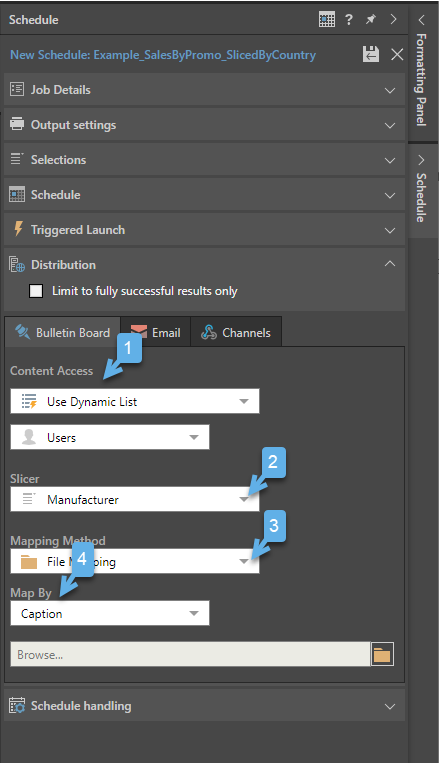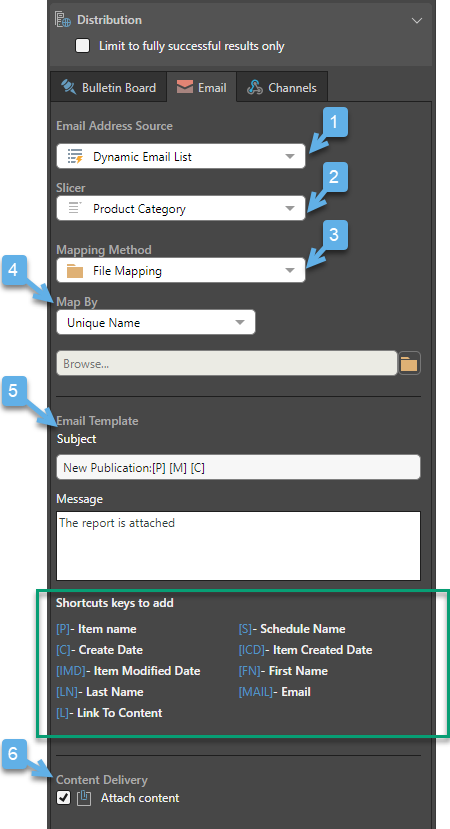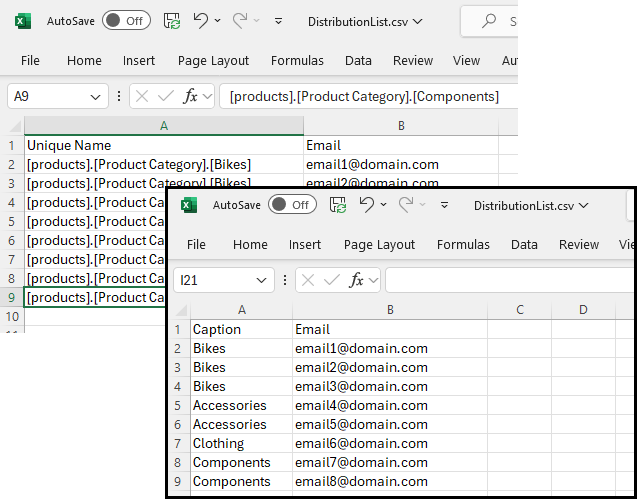File mapping is used to dynamically distribute publications to an existing list of roles, users, or emails. The distribution list contains the list of recipients, and the slice elements that they will be assigned to. The list is imported, and the publication distributed to each recipient according to the specified slicer element. This article reviews the process of configuring file mapping for both bulletin board and email distribution, and how to format and upload a distribution list.
To learn about configuring dynamic distribution based on user security, see Data Mapping.
File Mapping for Bulletin Board Distribution
Select this option to distribute to an imported list of roles or users using the Bulletin Board in Pyramid.
From the Schedule panel, select Distribution and then the Bulletin Board tab:
- From the Content Access options:
- Select Use Dynamic List.
- Choose whether to distribute using Roles or Users.
- From the Slicer drop-down, select the relevant slicer.
- Under Mapping Method, choose File Mapping.
- Under Map By:
- Choose either Unique Name or Caption. Captions are the slice names, such as Bikes or Accessories. Unique Names are the members described using PQL syntax, such as [Products].[ProductCategory].[Bikes].
- Import a Distribution List in comma-delimited text format (see below for details). Click the Folder icon next to the drop-down to find and import the distribution list from its file location.
If your report contains multiple slicers, choose the slicer that should be used to lookup the distribution list. This is the slicer whose elements appear in the distribution list that will be imported.

File Mapping for Email Distribution
Select this option to distribute to an imported list of email addresses.
From the Schedule panel, select Distribution and then the Email tab:
- From the Email Address Source drop-down, select Dynamic Email List.
- From the Slicer drop-down, select the relevant slicer.
- Under Mapping Method, choose File Mapping.
- Under Map By, create the mapping:
- Choose either Unique Name or Caption. Captions are the slice names, such as Bikes or Accessories. Unique Names are the members described using PQL syntax, such as [Products].[ProductCategory].[Bikes].
- Import a Distribution List in comma-delimited text format (see below for details). Click the Folder icon next to the drop-down to find and import the distribution list from its file location.
- Configure your email template.
- Select the Attach content checkbox if the publication should be attached to the email. This option is only available with the Extended Report Bursting license.
If your report contains multiple slicers, choose the slicer that should be used to lookup the distribution list. This is the slicer whose elements appear in the distribution list that will be imported.
If you don't want to attach the content to the email, you can clear this checkbox.

Shortcuts
Use the shortcuts (green highlight above) to add the required element to the subject line or message. For example, if you want to add a link to the presentation to your email add the Link to Content shortcut [L] to your email template. When the recipient of the email clicks the link, the presentation will be downloaded.
Upload a Distribution List
The Distribution List may be a .txt, .csv, or .tsv file. It maps the slicer members to email addresses or roles used as targets for the given slice. It should conform to the formatting displayed in the image below:

Important: The first row contains headers - the list of elements and target emails or roles starts from the second row.
- Column 1: The slicer elements. Row 1 (the header row) can take any value. All other rows in this column contain the names of the matching elements that are used in the slicer. These values must all be either Captions or Unique Names, with the format being dictated by your selection from the Map By drop-down list (4 above). Captions are the slice names, such as "Bikes" or "Accessories." Unique Names are the members described using PQL syntax, such as
[products].[Product Category].[Bikes]. Values are case sensitive. - Column 2: The matching email addresses or roles that are used as targets for the given slice value. Again, row 1 can take any value. All other rows represent the target emails or roles. Multiple emails can be included in a single column as a semi-colon separated list of values (see purple highlight). Note: Dynamic distribution to the bulletin board supports importing a list of roles or users.
This is the format that must be used, regardless of the number of slicers in the publication. If your publication contains multiple slicers, the distribution list should still contain only a single elements column, with elements from a single slicer only. The corresponding slicer should be selected from the Distribution window.